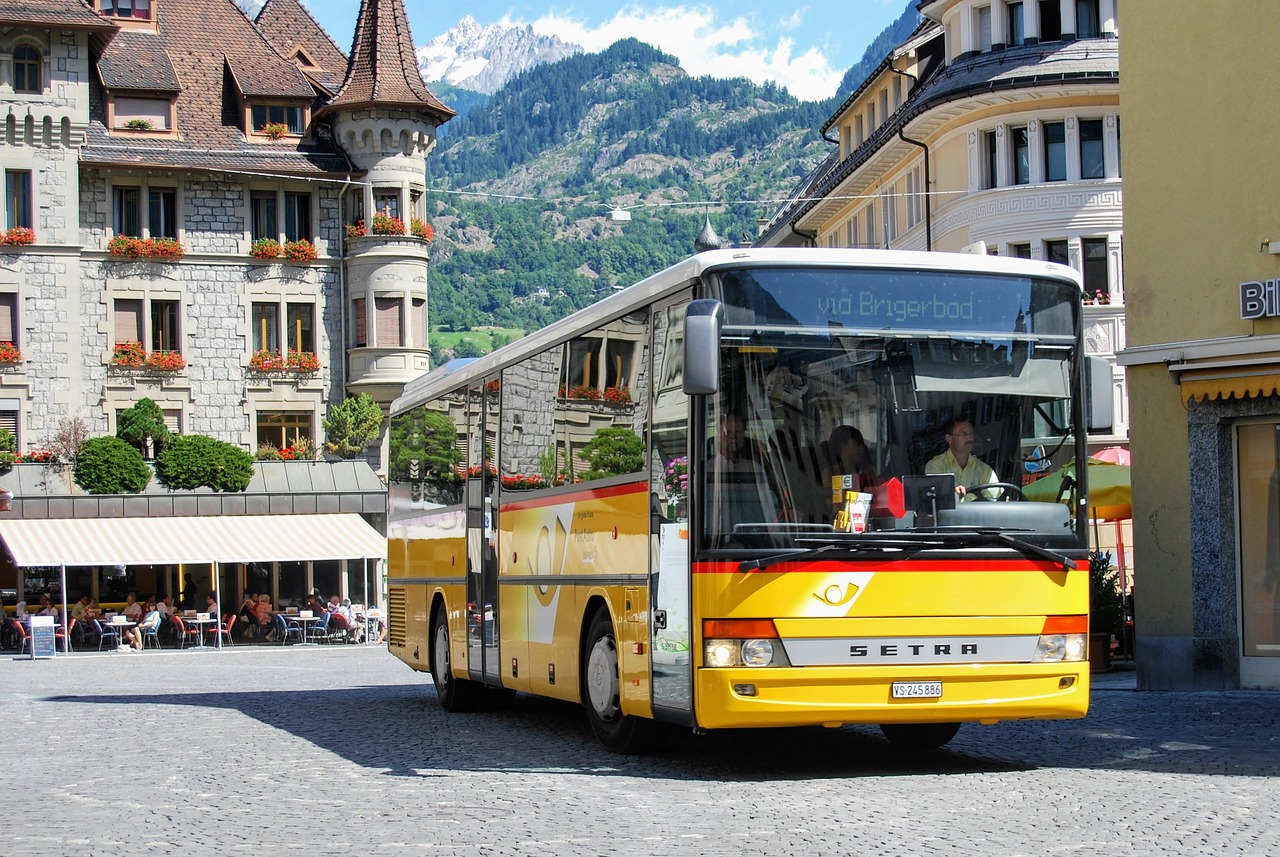10 Tips for Reducing Your Travel Carbon Footprint
Traveling sustainably is crucial in today's world. As we explore new destinations and immerse ourselves in different cultures, it's essential to be mindful of our environmental impact. By taking simple yet effective steps, we can significantly reduce our carbon footprint while still enjoying the beauty of travel.
One of the first steps towards sustainable travel is choosing eco-friendly accommodation. Opt for hotels or lodges that have green certifications or follow sustainable practices. By staying in such establishments, you can lower your environmental impact and support businesses that prioritize sustainability.
When it comes to getting around, opting for public transportation is a great way to reduce emissions. Instead of renting a car, consider using buses, trains, or subways. Not only does this help lower your carbon footprint, but it also supports local transportation systems and reduces traffic congestion.
Packing light is another effective way to reduce your travel carbon footprint. Traveling with lighter luggage decreases fuel consumption, leading to lower carbon emissions during flights or road trips. Plus, it makes your journey more convenient and hassle-free.
If you're looking to offset the carbon emissions generated from your travels, consider supporting carbon offset programs. These initiatives fund renewable energy projects that help compensate for the environmental impact of your journey, making your travels more sustainable.
Carrying reusable water bottles and shopping bags is a simple yet impactful way to reduce plastic waste while traveling. By minimizing single-use plastics, you can help protect the environment and reduce pollution in the destinations you visit.
Supporting local farmers and dining at restaurants that serve locally sourced and organic food is not only a culinary delight but also a sustainable choice. Eating local helps reduce the carbon footprint associated with food transportation and supports the local economy.
Exploring your destination by foot or bike is a fantastic way to experience it intimately while minimizing your carbon emissions. Walking or cycling allows you to slow down, take in the surroundings, and reduce your environmental impact compared to traditional modes of transportation.
During your stay, make an effort to conserve energy in your accommodation. Simple actions like turning off lights when not in use, adjusting the thermostat to an energy-efficient setting, and limiting water usage can significantly reduce your environmental footprint.
Spread awareness about sustainable travel practices and the importance of reducing carbon footprints. By educating others about the benefits of sustainable travel, you can inspire positive change in the travel industry and contribute to a more environmentally conscious world.

Choose Eco-Friendly Accommodation
Choosing eco-friendly accommodation is a crucial step in reducing your travel carbon footprint. By selecting hotels or lodges with green certifications or sustainable practices, you can significantly lower your environmental impact during your stay. These accommodations often implement energy-saving measures, waste reduction strategies, and water conservation efforts to minimize their carbon footprint.
When opting for eco-friendly accommodation, you are not only supporting environmentally responsible businesses but also contributing to the promotion of sustainable tourism. By staying at such establishments, you are sending a message to the hospitality industry that eco-conscious practices are important to travelers, thus encouraging more businesses to adopt green initiatives.
Additionally, eco-friendly accommodations often provide guests with opportunities to engage in sustainable activities, such as recycling programs, organic gardens, and eco-friendly amenities. This allows you to experience a more environmentally conscious way of traveling while enjoying a unique and eco-friendly stay.
Moreover, choosing eco-friendly accommodation can enhance your overall travel experience by immersing you in the local culture and environment. These establishments are often located in scenic and pristine areas, offering guests a chance to connect with nature and support the preservation of natural habitats.
Next time you plan a trip, consider the impact of your accommodation choice and opt for eco-friendly options that align with your values. By making conscious decisions about where you stay, you can contribute to a more sustainable travel industry and reduce your carbon footprint while exploring the world.

Opt for Public Transportation
When it comes to reducing your travel carbon footprint, opting for public transportation is a game-changer. Instead of relying on rental cars or taxis, using buses, trains, or subways can significantly lower emissions and support the local transportation infrastructure. Not only does public transportation help decrease traffic congestion, but it also promotes a more sustainable way of exploring a destination.
By choosing public transportation, you are actively contributing to the reduction of greenhouse gas emissions, which play a major role in climate change. Imagine the impact if every traveler decided to hop on a bus or train instead of driving a separate vehicle. It's like planting trees to absorb carbon dioxide from the atmosphere, but in this case, you're reducing emissions directly by sharing rides with others.
Additionally, public transportation allows you to immerse yourself in the local culture and interact with residents in a way that driving cannot offer. You get to see the city from a different perspective, observe daily life up close, and support the community by using their public services. It's like embarking on a mini adventure within your main travel experience, adding layers of authenticity and connection to your journey.
Next time you plan a trip, consider the convenience and eco-friendly benefits of public transportation. Whether it's a double-decker bus in London, a bullet train in Japan, or a tram in San Francisco, each ride contributes to a greener future for travel. So, why not skip the stress of navigating unfamiliar roads and parking lots, and instead, sit back, relax, and enjoy the scenic route while reducing your carbon footprint along the way?

Pack Light
When it comes to reducing your travel carbon footprint, one essential tip is to . Not only does traveling with lighter luggage make your journey more manageable, but it also has a significant impact on the environment. By carrying fewer items, you contribute to decreasing fuel consumption, which ultimately leads to lower carbon emissions during flights or road trips. Imagine your suitcase as a mini carbon footprint - the lighter it is, the less strain it puts on the environment.

Offset Your Carbon Emissions
Offsetting your carbon emissions is a proactive way to mitigate the environmental impact of your travels. By supporting carbon offset programs, you can contribute to projects that reduce greenhouse gas emissions and promote sustainable practices.
These programs typically involve investing in renewable energy projects such as wind farms, solar installations, or reforestation initiatives. Through financial contributions, you can help counterbalance the carbon dioxide released into the atmosphere from activities like air travel, driving, or accommodation.
When you offset your carbon emissions, you are essentially taking responsibility for the environmental consequences of your journeys. It's a tangible way to support the transition to a low-carbon economy and combat climate change on a personal level.
Many airlines and travel companies now offer carbon offset options when booking flights or tours. Additionally, there are independent organizations that specialize in carbon offsetting and allow individuals to calculate and compensate for their carbon footprint.
Offsetting your carbon emissions is not a perfect solution to the environmental challenges we face, but it is a step in the right direction. It demonstrates a commitment to sustainability and helps fund projects that contribute to a greener future for our planet.

Use Reusable Water Bottles and Bags
When it comes to reducing your travel carbon footprint, using reusable water bottles and bags can make a significant impact. By opting for reusable items, you can minimize plastic waste and help protect the environment in the destinations you visit.
Imagine strolling through a picturesque town, sipping water from your durable, refillable water bottle instead of contributing to the plastic pollution crisis. Not only does this simple switch benefit the planet, but it also keeps you hydrated throughout your adventures without relying on single-use plastics.
Similarly, carrying reusable bags while shopping for souvenirs or groceries can reduce the demand for plastic bags that often end up in landfills or oceans. These eco-friendly bags are not only sturdy and practical but also serve as a reminder of your commitment to sustainable travel practices.
Picture yourself exploring a bustling market, effortlessly storing your purchases in a reusable bag that showcases both style and sustainability. By choosing to use these environmentally friendly alternatives, you are not only protecting the planet but also setting an example for others to follow.
Next time you embark on a journey, consider the positive impact of using reusable water bottles and bags. Your small actions can collectively contribute to a greener future for our planet.

Eat Local and Sustainable
When it comes to reducing your travel carbon footprint, one delicious way to contribute to sustainability is by eating local and sustainable. By choosing to dine at restaurants that prioritize locally sourced and organic ingredients, you not only support the local economy but also help lower your environmental impact.
Picture yourself savoring a farm-to-table meal where the ingredients are freshly harvested from nearby farms, reducing the carbon emissions associated with transportation. This culinary experience not only tantalizes your taste buds but also minimizes the carbon footprint of your dining choices.
Furthermore, opting for local and sustainable food options often means supporting small-scale farmers who use eco-friendly practices. These farmers prioritize environmental conservation and promote biodiversity, contributing to a healthier planet.
Imagine indulging in a dish made with ingredients that have been grown without harmful pesticides or chemicals, knowing that your meal is not only delicious but also environmentally responsible. By choosing to eat local and sustainable, you become a conscious traveler who values the connection between food, community, and the environment.

Explore by Foot or Bike
When it comes to exploring a new destination, there's no better way to immerse yourself in the local culture and environment than by exploring on foot or bike. Choosing to explore by foot or bike not only allows you to experience the destination intimately but also helps in reducing your travel carbon footprint significantly.
Picture this: strolling through the charming streets of a historic city, soaking in the sights, sounds, and smells that you would miss if you were in a car. Or cycling along scenic routes, feeling the wind in your hair and the sun on your face as you discover hidden gems off the beaten path. By choosing to explore on foot or bike, you're not only reducing your carbon emissions but also contributing to a more sustainable and eco-friendly way of travel.
Walking or cycling also gives you the flexibility to stop whenever you please, interact with locals, and discover places that might be inaccessible by car. It's a more leisurely pace that allows you to truly appreciate the beauty of your surroundings without leaving a large carbon footprint behind.
Additionally, exploring by foot or bike promotes a healthier lifestyle, giving you the opportunity to stay active while on vacation. It's a win-win situation where you not only benefit the environment but also your own well-being.

Conserve Energy in Your Accommodation
When it comes to staying in accommodation during your travels, there are simple yet effective ways to conserve energy and reduce your carbon footprint. One of the easiest ways to do this is by being mindful of your energy usage in your hotel room or rental property. Remember, every little effort counts towards a more sustainable future.
Start by turning off lights, air conditioning, and heating when you leave your room. Not only does this help save energy, but it also reduces the overall environmental impact of your stay. Additionally, consider adjusting the thermostat to a moderate temperature to avoid unnecessary energy consumption.
Another way to conserve energy is by limiting water usage. Take shorter showers, turn off the tap while brushing your teeth, and report any leaks or drips to the hotel staff promptly. Water conservation is closely linked to energy conservation, as the process of heating water consumes a significant amount of energy.
Furthermore, make use of natural light during the day instead of relying on artificial lighting. Open the curtains or blinds to let sunlight in, creating a bright and welcoming atmosphere while reducing the need for electricity. If you need additional lighting, opt for energy-efficient bulbs to minimize energy consumption.
Consider unplugging electronic devices and chargers when they are not in use. Even when turned off, these devices can still draw power from the outlet, known as standby power consumption. By unplugging them, you can prevent unnecessary energy wastage and contribute to a greener stay.
Lastly, engage with the hotel's sustainability initiatives if available. Some accommodations offer guests the option to participate in energy-saving programs or reuse towels and linens to reduce water and energy usage. By supporting these efforts, you actively contribute to the conservation of resources and the preservation of the environment.
Q: How can I ensure that the accommodation I choose follows energy-saving practices?
A: Before booking your stay, research the hotel's or lodge's sustainability initiatives. Look for certifications such as LEED or Green Key that indicate a commitment to eco-friendly practices. You can also reach out to the accommodation directly to inquire about their energy-saving measures.
Q: Are there any specific actions I can take to reduce energy consumption in a vacation rental?
A: Yes, you can start by being mindful of your energy usage, similar to staying in a hotel. Turn off lights, appliances, and heating/cooling systems when not in use, and consider using natural light during the day. Additionally, communicate with the rental owner or management about your interest in conserving energy during your stay.
Q: How does conserving energy in accommodation contribute to sustainable travel?
A: Conserving energy in your accommodation reduces the overall carbon footprint of your trip. By minimizing energy consumption, you help lower greenhouse gas emissions and support a more environmentally friendly travel experience. Your actions can inspire others to adopt similar practices and promote a culture of sustainability within the travel industry.

Spread Awareness
Spreading awareness about sustainable travel practices is essential in creating a positive impact on the environment and the travel industry as a whole. By educating others about the importance of reducing carbon footprints, you can inspire individuals to make conscious choices that contribute to a greener future. Whether it's sharing your own experiences, engaging in conversations about eco-friendly travel, or promoting responsible tourism, every effort counts in raising awareness.
One effective way to spread awareness is through social media platforms. Utilize your online presence to showcase how simple changes in travel behavior can make a significant difference. Share tips, articles, and personal stories that highlight the benefits of sustainable travel and encourage your followers to join the movement towards eco-conscious exploration.
Engaging with local communities and organizations is another impactful way to raise awareness about reducing carbon footprints while traveling. Collaborate with eco-friendly businesses, participate in environmental initiatives, or volunteer for sustainability projects during your journeys. By actively involving yourself in green initiatives, you can lead by example and inspire others to follow suit.
Organizing or participating in workshops, seminars, or events focused on sustainable travel practices can also be a powerful tool for spreading awareness. By providing practical information, sharing success stories, and discussing the challenges and solutions of eco-friendly travel, you can empower individuals to make informed choices that benefit the planet and future generations.
Additionally, incorporating sustainability messages in your travel blogs, vlogs, or articles can help reach a wider audience and influence readers to adopt environmentally friendly habits. By weaving sustainability into your travel narratives and showcasing how it enhances the overall experience, you can inspire others to prioritize eco-conscious decisions in their own adventures.
Remember, every action you take to spread awareness about reducing carbon footprints in travel contributes to a collective effort towards a more sustainable and environmentally conscious world. By being a vocal advocate for responsible tourism and sharing the positive impacts of eco-friendly practices, you can inspire others to make a difference one journey at a time.
Frequently Asked Questions
- What is a carbon footprint?
A carbon footprint is the total amount of greenhouse gases, specifically carbon dioxide, that are generated by human activities. This includes emissions from transportation, energy use, and other daily practices that contribute to climate change.
- How can I calculate my travel carbon footprint?
You can calculate your travel carbon footprint using online calculators that take into account factors such as the distance traveled, mode of transportation, and accommodation choices. These tools provide an estimate of the emissions produced during your trip.
- Why is sustainable travel important?
Sustainable travel is crucial for preserving the environment, supporting local communities, and combating climate change. By reducing carbon footprints and practicing responsible tourism, travelers can help protect natural resources and promote a more sustainable future for the planet.
- What are carbon offset programs?
Carbon offset programs are initiatives that fund projects aimed at reducing greenhouse gas emissions to counterbalance the environmental impact of activities like travel. These projects can include renewable energy installations, reforestation efforts, and energy efficiency programs.
- How can I support sustainable tourism?
You can support sustainable tourism by choosing eco-friendly accommodations, minimizing waste, respecting local cultures, and engaging in activities that have a positive impact on the environment and communities you visit. Additionally, spreading awareness and advocating for sustainable practices can help drive positive change in the travel industry.



















